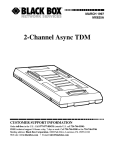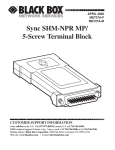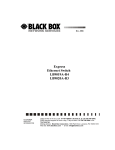Download E1 12-Port Access Multiplexor Module
Transcript
MARCH 2001 LRA1209C E1 12-Port Access Multiplexor Module E1 s Acces or ex Multipl PWR AL LK RX TX 1 2 3 4 5 E 1 6 7 8 9 10 11 12 CUSTOMER SUPPORT INFORMATION Order toll-free in the U.S.: Call 877-877-BBOX (outside U.S. call 724-746-5500) FREE technical support 24 hours a day, 7 days a week: Call 724-746-5500 or fax 724-746-0746 Mailing address: Black Box Corporation, 1000 Park Drive, Lawrence, PA 15055-1018 Web site: www.blackbox.com • E-mail: [email protected] FCC INFORMATION FEDERAL COMMUNICATIONS COMMISSION AND INDUSTRY CANADA RADIO FREQUENCY INTERFERENCE STATEMENTS This equipment generates, uses, and can radiate radio frequency energy and if not installed and used properly, that is, in strict accordance with the manufacturer’s instructions, may cause interference to radio communication. It has been tested and found to comply with the limits for a Class A computing device in accordance with the specifications in Subpart J of Part 15 of FCC rules, which are designed to provide reasonable protection against such interference when the equipment is operated in a commercial environment. Operation of this equipment in a residential area is likely to cause interference, in which case the user at his own expense will be required to take whatever measures may be necessary to correct the interference. Changes or modifications not expressly approved by the party responsible for compliance could void the user’s authority to operate the equipment. This digital apparatus does not exceed the Class A limits for radio noise emission from digital apparatus set out in the Radio Interference Regulation of Industry Canada. Le présent appareil numérique n’émet pas de bruits radioélectriques dépassant les limites applicables aux appareils numériques de la classe A prescrites dans le Règlement sur le brouillage radioélectrique publié par Industrie Canada. 1 E1 12-PORT ACCESS MULTIPLEXOR MODULE NORMAS OFICIALES MEXICANAS (NOM) ELECTRICAL SAFETY STATEMENT INSTRUCCIONES DE SEGURIDAD 1. Todas las instrucciones de seguridad y operación deberán ser leídas antes de que el aparato eléctrico sea operado. 2. Las instrucciones de seguridad y operación deberán ser guardadas para referencia futura. 3. Todas las advertencias en el aparato eléctrico y en sus instrucciones de operación deben ser respetadas. 4. Todas las instrucciones de operación y uso deben ser seguidas. 5. El aparato eléctrico no deberá ser usado cerca del agua—por ejemplo, cerca de la tina de baño, lavabo, sótano mojado o cerca de una alberca, etc.. 6. El aparato eléctrico debe ser usado únicamente con carritos o pedestales que sean recomendados por el fabricante. 7. El aparato eléctrico debe ser montado a la pared o al techo sólo como sea recomendado por el fabricante. 8. Servicio—El usuario no debe intentar dar servicio al equipo eléctrico más allá a lo descrito en las instrucciones de operación. Todo otro servicio deberá ser referido a personal de servicio calificado. 9. El aparato eléctrico debe ser situado de tal manera que su posición no interfiera su uso. La colocación del aparato eléctrico sobre una cama, sofá, alfombra o superficie similar puede bloquea la ventilación, no se debe colocar en libreros o gabinetes que impidan el flujo de aire por los orificios de ventilación. 10. El equipo eléctrico deber ser situado fuera del alcance de fuentes de calor como radiadores, registros de calor, estufas u otros aparatos (incluyendo amplificadores) que producen calor. 11. El aparato eléctrico deberá ser connectado a una fuente de poder sólo del tipo descrito en el instructivo de operación, o como se indique en el aparato. 2 NOM STATEMENT 12. Precaución debe ser tomada de tal manera que la tierra fisica y la polarización del equipo no sea eliminada. 13. Los cables de la fuente de poder deben ser guiados de tal manera que no sean pisados ni pellizcados por objetos colocados sobre o contra ellos, poniendo particular atención a los contactos y receptáculos donde salen del aparato. 14. El equipo eléctrico debe ser limpiado únicamente de acuerdo a las recomendaciones del fabricante. 15. En caso de existir, una antena externa deberá ser localizada lejos de las lineas de energia. 16. El cable de corriente deberá ser desconectado del cuando el equipo no sea usado por un largo periodo de tiempo. 17. Cuidado debe ser tomado de tal manera que objectos liquidos no sean derramados sobre la cubierta u orificios de ventilación. 18. Servicio por personal calificado deberá ser provisto cuando: A: El cable de poder o el contacto ha sido dañado; u B: Objectos han caído o líquido ha sido derramado dentro del aparato; o C: El aparato ha sido expuesto a la lluvia; o D: El aparato parece no operar normalmente o muestra un cambio en su desempeño; o E: El aparato ha sido tirado o su cubierta ha sido dañada. 3 E1 12-PORT ACCESS MULTIPLEXOR MODULE TRADEMARKS USED IN THIS MANUAL Any trademarks mentioned in this manual are acknowledged to be the property of the trademark owners. 4 CHAPTER 1: Introduction 1. Introduction The E1 12-Port Access Multiplexor Module is a 12-port module for use with the 2 x 12 or 1 x 4 slot DSLAM Chassis. The module attaches to each Multiplexor Uplink Module (MUM) via a 10-/100-Mbps Ethernet connection on the backplane. Each E1 port translates the outgoing Ethernet frame to E1 via media conversion. This is a Layer-1 conversion, where the native frames are then passed across the E1 link, over a copper pair to an E1 Subscriber Unit. Received WAN frames are converted back to Ethernet and forwarded to the appropriate backplane port. No routing or translational bridging is done internally. The connection across the E1 line may be a fractional or full E1. Speed is hardware- or software-selectable per port (software overrides hardware settings) and determined by the E1 12-Port Access Multiplexor Module. Eight speed (bandwidth) settings are possible: 256, 512, 768, 1024, 1280, 1536, 1792, and 1984 kbps. The remote Subscriber Unit will determine its line speed through communication with the 12-Port Module. E1 technology is intended for use from the telephone company central office across the local loop to the home or business, or may also be used to transport data between locations over E1 lines. 5 E1 12-PORT ACCESS MULTIPLEXOR MODULE 2. Installation 2.1 Bandwidth Selection The E1 12-Port Access Multiplexor Module provides 8 bandwidth options for the E1 link, as mentioned in Chapter 1. Two switch banks (12 switches per bank) located on the circuit board are used to select the default bandwidth. The switches affect the operation of the E1 connection only. These switches are paired in groups of two, with each group affecting a single E1 port. Table 1 depicts switch/port associations. Table 1. Switch/port associations. Upper Switch Bank Switches 2 6 12 20 30 42 Port 1 Port 2 Port 3 Port 4 Port 5 Port 6 Middle Switch Bank Switches 1–2 3–4 5–6 7–8 9–10 11–12 Port 7 Port 8 Port 9 Port 10 Port 11 Port 12 Table 2 shows the switch settings used to determine the default speed setting per port. When operating a port as a Fractional E1 line, the equipment requires contiguous timeslots, as indicated Table 2. Default speed settings. 6 Switch One Switch Two ON OFF ON OFF ON ON OFF OFF Timeslots 1–31 1–24 1–16 1–8 Bandwidth 1.984 Mbps 1.536 Mbps 1.024 Mbps 512 kbps CHAPTER 2: Installation A third (lower) switch bank selects the following (see Table 3) for all of the E1 lines. Table 3. E1 line settings. Switch ON OFF 1 (Framing) 2 (Line Coding) 3 (Not Used) 4 (Not Used) 5 (Timing) 6 (Not Used) E1 (CRC) HDB3 E1 (no CRC) AMI Local Loop The E1 12-Port Access Multiplexor Module ships with all switches in the ON position, meaning each port will run at 1.984 Mbps, E1 (CRC) Framing, HDB3 Line Coding, and Local Timing by default. NOTE Speed settings made via the Web Management System override the hardware settings. 7 E1 12-PORT ACCESS MULTIPLEXOR MODULE 2.2 Port Pinout Table 4 lists the pinout for the E1 RJ-21 connector. Table 4. E1 RJ-21 connector pinout. Port 1 2 3 4 5 6 7 8 9 10 11 12 8 Pin 26 1 27 2 28 3 29 4 30 5 31 6 32 7 33 8 34 9 35 10 36 11 37 12 Pin RxT RxR RxT RxR RxT RxR RxT RxR RxT RxR RxT RxR RxT RxR RxT RxR RxT RxR RxT RxR RxT RxR RxT RxR 39 14 40 15 41 16 42 17 43 18 44 19 45 20 46 21 47 22 48 23 49 24 50 25 TxT TxR TxT TxR TxT TxR TxT TxR TxT TxR TxT TxR TxT TxR TxT TxR TxT TxR TxT TxR TxT TxR TxT TxR CHAPTER 2: Installation 2.3 LED Indicators Each E1 port features these status LEDs for at-a-glance monitoring: • PWR: Steady green indicates normal operation. • LK: Pulsing green (once per second) indicates E1 connection is operational and the unit is receiving either valid data packets or status packets from the remote unit on the other side of the E1 connection. Solid green indicates link (frame synchronization), but no traffic is being received. No green indicates red alarm (carrier failure alarm). • RX: Flashing amber indicates data received from the E1 line. • TX: Flashing amber indicates data transmit to the T1 line. • AL: Solid amber indicates AIS (alarm indication signal). 9 © Copyright 2001. Black Box Corporation. All rights reserved. 1000 Park Drive • Lawrence, PA 15055-1018 • 724-746-5500 • Fax 724-746-0746























